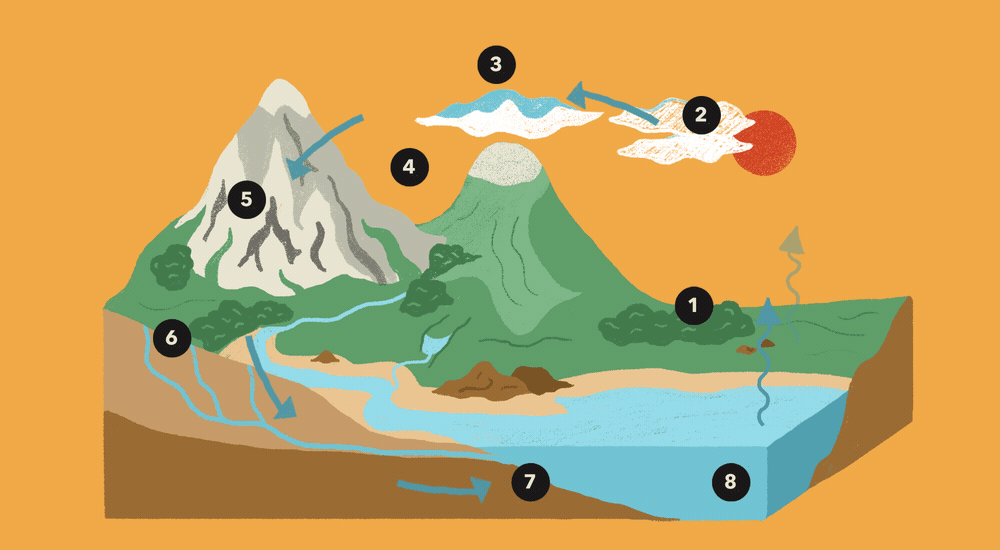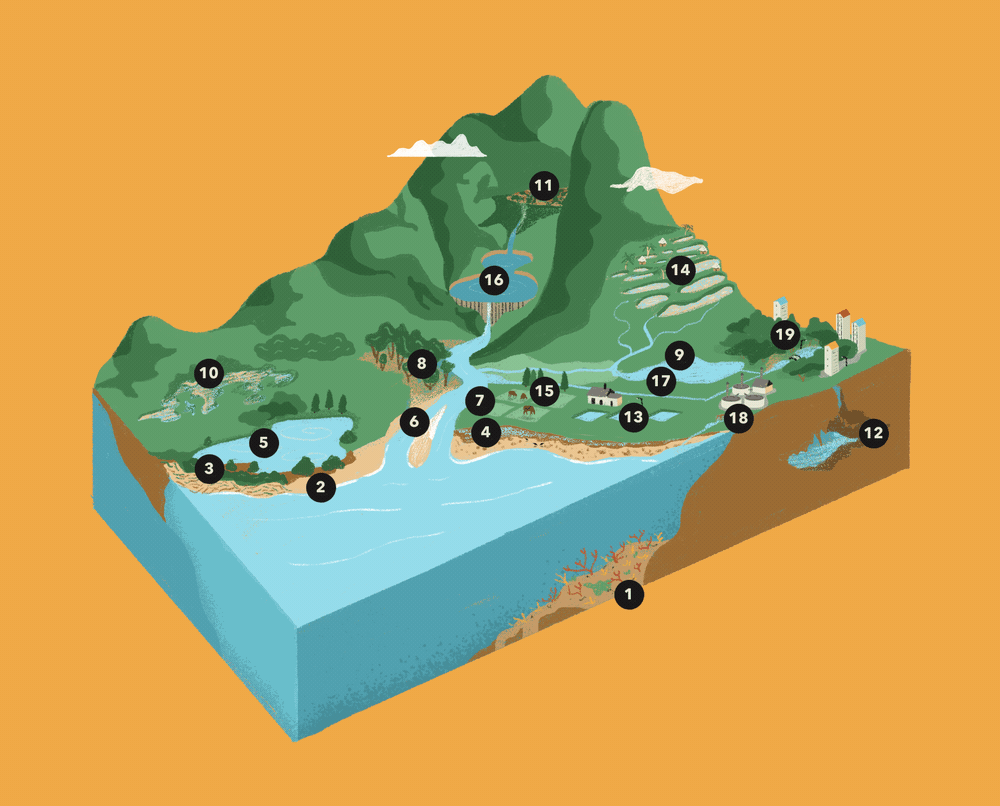Our relationship with water and wetlands
| Site: | OpenLearn Create |
| Course: | 6 Community Wetland Management |
| Book: | Our relationship with water and wetlands |
| Printed by: | Guest user |
| Date: | Sunday, 23 November 2025, 1:39 AM |
1. Water
Water is fundamental to life. All organisms need water to be able to survive. Water is considered the universal solvent because essential nutrients for life can dissolve within it. Water is therefore an important delivery mechanism that transports vital nutrients from one place to another within a cell keeping us and other organisms alive.
The unique thing about water is that all three states (liquid, solid and gas) exist naturally in nature. This ability allows the water cycle to replenish water around the world, particularly maintaining fresh water which we need to survive.

- Evaporation and transpiration
- Condensation
- Water storage in the atmosphere
- Precipitation
- Runoff
- Infiltration
- Groundwater discharge
- Water storage in oceans
2. Wetlands
Wetlands are habitats where water permanently covers the ground or is present at or near the ground surface for some of the year. These waterlogged conditions result in changes to the soil and allows specially adapted plants and animals to live there.
Wetlands are often dynamic habitats where water levels can change from dry to flooded and back again. Wetlands include natural habitats such as mangroves, peatlands, wet grasslands, marshes, rivers and their floodplains, lakes, deltas, wet woodlands and coral reefs and human made habitats such as rice-fields, fish ponds and water treatment constructed wetlands. Wetlands exist in every country and in every climatic zone, from the polar regions to the tropics, and from high altitudes to dry regions.
The video below introduces an example of an important wetland found in Guyana, South America.
2.1. Types of wetlands
Marine / coastal wetlands
1. Coral reef
2. Mudflat
3. Mangrove
4. Saltmarsh
5. Coastal lagoon
6. Estuary
Inland wetlands
7. Wet grassland on river floodplain
8. Wet woodland on river floodplain
9. Lake
10. Marsh / pond
11. Peatland
12. Cave
Human-made wetlands
13. Aquaculture pond
14. Irrigated agriculture wetland e.g. rice paddy
15. Pasture along river
16. Reservoir
17. Canal
18. Water treatment wetland
19. Park with ponds etc.
2.2. Benefits of wetlands
Wetlands are incredibly important for wildlife and people. Humans and the natural world, with all of its biodiversity, depend upon the healthy functioning of wetlands and the benefits they provide including resources such as food, water and shelter, regulation of the climate and natural hazards such as flood and storm protection, important processes such nutrient cycling and carbon storage and for humans cultural and social benefits such as maintaining health and well-being.
![]()
- Wetlands ensure freshwater for all – they supply clean water
- Wetlands filter harmful waste from water – they treat pollution
- Wetlands can store carbon and mitigate climate change
- Wetlands are critical for biodiversity
- Wetlands guarantee our food supply e.g. fish and plants such as rice
- Wetland plants are harvested for fuel and fibre
- Wetlands sustain livelihoods e.g tourism
- Floodplains, lakes and marshes can absorb flood waters
- Lakes, ponds and marshes can maintain groundwater levels and prevent drought
- Coastal wetlands can prevent shoreline erosion
- Coastal wetlands can reduce storm damage from wave and cyclone impacts
- Wetlands are important spaces for recreation and cultural activities
3. Our relationship with water and wetlands
Unfortunately, human activities, throughout history, have had negative impacts on water and wetlands which threaten the important benefits they provide to us and all life on earth. Since the 1970s approximately 35% of the world’s wetlands have been destroyed through drainage and conversion to agriculture or urban areas. The remaining wetlands and the water they provide have been degraded through pollution, water abstraction, water diversions and resource extraction. Inappropriate agriculture, industry and urban areas disrupt the natural water dynamics of wetlands, negatively impact water quality through solid waste and wastewater pollution and diminish them through unsustainable extraction of food products and resources such as timber, peat and soil. As a result of human activities, the planet is experiencing climate change and biodiversity loss crises. For example, freshwater dependent populations of wildlife species have declined by 84% since 1970. This obviously has had a direct impact on water and wetlands and the benefits they provide for us and for wildlife.
To change this downward decline, we need to change how we have been approaching agriculture, industry and urbanisation. We need to come together as communities to identify and share best practices in wetland and water management to avoid negative impacts on the wetlands and water we rely on.
This video, by IWMI, provides an example of the urban wetlands of Colombo, Sri Lanka and the relationship they have with the people that live and work in the city.
Now, after having finished this book, make sure to go back to the main page and complete activity 1.
